If you didn't get this, you should see it. It may be personalization run amok, but it's always nice to be thanked!
http://my.barackobama.com/
There is one particularly interesting thing about it. They are pushing sharing, but they appear to have controlled it carefully. I tried sending it to BlogReaders--I thought that would be a nice touch; when that didn't work, I used the word Reader, hoping it would recognize that as a given name. No luck--in both cases, it came back personalized to Friend. When I send it to Robert, it recognized a real name and personalized. Nice filter! Don't give them credit for thinking this up, however. In March 2008 I wrote about a video sent to a student during the Dutch political campaign. Not as elaborate, but perhaps a bit funnier. Last fall another student ran the (winning) campaign for the Conservative Party in Norway using a lot of electronic and social media.
Don't give them credit for thinking this up, however. In March 2008 I wrote about a video sent to a student during the Dutch political campaign. Not as elaborate, but perhaps a bit funnier. Last fall another student ran the (winning) campaign for the Conservative Party in Norway using a lot of electronic and social media.
The key is that both countries have election laws that permit only a minimal amount of money to be spent (and a short time in which to spend it). What a good idea! Wish I believed it could ever happen here!!!
I'll see you early in the new year. Let me add my wishes to those of the famous friend for a wonderful holiday season for all!!!
Monday, December 21, 2009
Personalized Email From "A Friend"
Posted by MaryLou Roberts at 10:48 AM 0 comments
Labels: new media, personalization, social media, social media strategy
Friday, December 18, 2009
Ghost of Christmas Future?
It’s no secret that I think apps are the future, and we can see it emerging now. However, I’m not a big mall shopper, so I haven’t experimented with shopping apps for my iPhone except for a grocery list, which I quickly became unable to live without. My students are on the same wave length. In fact, last night one tried to convince the class that we wanted to listen to sports events on our smart phones! No sale there, Laura! but I was thinking about apps when I saw this article in the NYT today. The idea of mobile phones as an essential tool for shopping intrigues me, although it may strike fear into the hearts of some retailers.
The video is fascinating, so I decided to experiment. I downloaded the free ShopSavvy app with no trouble. However, it didn’t work. Ok, go read some more. I found out that it only works on the iPhone 3Gs. Reason: older iPhones lack the autofocus function that makes a bar code readable.
Is there a bar code scanner app for the 3G? Yes, I found RedLaser and it looked pretty good. I downloaded that, although along the way I had to update my iPhone software; that took longer than the two app downloads together. After that, $1.99 and a few seconds later, I had a bar code scanner.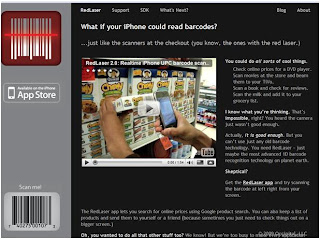 First thing I tried was a Diet Coke can. The UPC is on the side, so the can kept rolling around and getting glare from the metal; never did get it to work. However, I pointed the scanner at the bar code on the RedLaser site, and moments later I had lift off! The code is for a snuggles blanket and it sells for as little as $11.99 online and shows $14.99 at both Best Buy and Sears, which are near me. And I didn’t need to try to integrate it with the ShopSavvy app; it gave me results from Google search and from the Find. Fascinating!
First thing I tried was a Diet Coke can. The UPC is on the side, so the can kept rolling around and getting glare from the metal; never did get it to work. However, I pointed the scanner at the bar code on the RedLaser site, and moments later I had lift off! The code is for a snuggles blanket and it sells for as little as $11.99 online and shows $14.99 at both Best Buy and Sears, which are near me. And I didn’t need to try to integrate it with the ShopSavvy app; it gave me results from Google search and from the Find. Fascinating!
Thank goodness I’ve finished my Christmas shopping, but I decided to check how well I did on one item. The hard drive I bought sells for as little as $109.95 online and as much as $179.99 at retail outlets and some online merchants. So I did just fine—thanks to a sale and loyal customer discount at Staples! Are you surprised at the price range? I was! Of course, customers will think about shipping when they see the online prices. Does this kind of shopping confirm the wisdom of all the free shipping offers we are seeing this holiday season?
This is all pretty new, and not that many shoppers are yet using it. What about next Christmas? Fearless Roberts prediction; this is going to catch on fast. Corollary to that; if I can do it, anyone else with a smart phone can!
Retailers, both online and off, seem to have two choices. They can offer to meet the lowest price; notice that Wal-Mart’s price matching offer (current TV ad appears to simply restate the policy on their site) excludes online prices. That obviously can cut into a retailer’s margin—and what if it’s counter to the merchandising strategy?
I would describe the second option as, “you can’t beat them, so join them.” I’ve previously described apps intended to make it easier to shop at certain stores or buy certain brands. That is going to make sense, at least for first movers for awhile. Like everything else, however, there will be a limit to how many apps customers want.
Is this within range of small local retailers? I searched again and found this site; the costs are consistent with what I’ve seen before and on the low end are not excessive.
Should retailers—large and small—be thinking right now about next Christmas and how they can take advantage of the trend to mobile-assisted shopping?
Posted by MaryLou Roberts at 1:22 PM 0 comments
Labels: location-based marketing, mobile, mobile marketing, mobile shopping, social applications
Thursday, December 17, 2009
Repower America's Video Wall
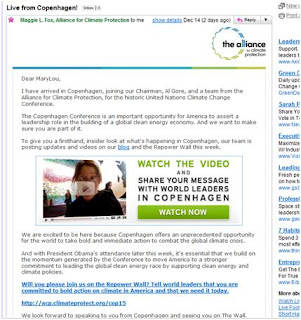 As the climate summit began in Copenhagen I received this email from Repower America. While none of the supporting activities are strikingly new, some of them are interesting.
As the climate summit began in Copenhagen I received this email from Repower America. While none of the supporting activities are strikingly new, some of them are interesting.
Their communications in and from Copenhagen center around a wall created just for the purpose. It’s worth either watching the video or going directly there. Videos on walls are nothing new; a video wall is new to me. So much for the technology. The content blends contributions from corporate promoters of efforts to halt climate change with the submissions of well-known people in the field and of the general public. That alone is interesting. The corporate activists are interesting; some are acting in terms of their mission, some clearly in self interest, and others were something of a surprise to me. You can mouse-over the wall and see for yourself.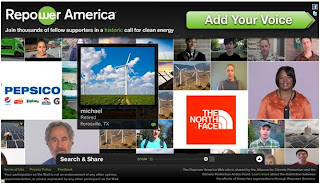 It took effort to get the wall up and provisioned with a credible number of videos in just a month. I’m sure that they did a lot of reach out; here’s how some of it went in the blogosphere.
It took effort to get the wall up and provisioned with a credible number of videos in just a month. I’m sure that they did a lot of reach out; here’s how some of it went in the blogosphere.
This is a little different from the usual cause-related marketing in which one corporate sponsor usually plays a leading role, whether or not there are multiple sponsors. I was going to use Komen Race for the cure as a good example; I see they’ve gone beyond a single major sponsor plus many lesser sponsorships. Their sponsorship page is fascinating. It links to a page with 5 questions corporations should ask when considering cause sponsorship. The questions are excellent; they provide a useful framework for non-profits that are considering a major sponsorship push.
I’ll make the point again. Cause-related marketing not only is a heavy user of social media, it is part and parcel of social media strategy. Corporations are searching for ways to relate to and engage customers and potential customers in a way that does not mimic the intrusiveness of traditional media advertising. Cause-related marketing presents one superb solution, aligning the corporation with a worthwhile cause and providing visibility and support for the cause. Everybody wins!
Posted by MaryLou Roberts at 11:05 AM 0 comments
Labels: cause-related marketing, social media strategy, user generated content, video
Wednesday, December 16, 2009
Are Lawyers Going Social?
I was aware of the website LegalZoom through its TV ads featuring celebrity attorney Robert Shapiro. That was all until a student pointed out their other online activities, which I found quite unusual for a legal firm—thanks, Fiesal!
The current centerpiece of the online strategy is a contest, just concluded, that allows customers to upload videos about their experience with LegalZoom. Here’s their YouTube video. The embed looks like nothing special, but play it all the way through—the 40 seconds is worth what you find at the end. When the video finishes you get thumbnails of customer videos that have been submitted. I don’t know how to do that, but it’s very cool and it makes the point that people are entering the contest.
That brings me to my favorite question: how did they let customers know about it. I’ll bet there were outbound communications, through their corporate newsletter probably. I have visited the site several times recently, and I didn’t see a notice about the contest. It has its own separate website, which links back to the corporate site, but I don’t find anything on the corporate site that links to the contest site, although entries to the contest have been closed for five days now, giving them enough time to remove a notice. Given the care with which they do other things, and the fact they are lawyers, I doubt that is an accident. That guess is supported by the fact that the winners are not scheduled to be announced until December 20—5 days from now. CPG sites would be hyping the winner announcement.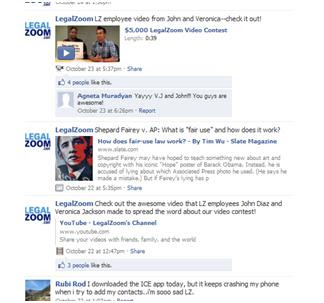 Ok, there is a separate website; you still have to get customers to that website. They have a very active Facebook page; I’d recommend it as a “best practices” business Facebook page. It’s active; there are a lot of informative links. They have only 1,197 fans at this point, but they used the Facebook page aggressively to promote the contest. The screen capture shows 2 posts announcing the contest. There were others throughout the contest. The last entry I saw was on December 7, promoting the last chance to vote on the contest.
Ok, there is a separate website; you still have to get customers to that website. They have a very active Facebook page; I’d recommend it as a “best practices” business Facebook page. It’s active; there are a lot of informative links. They have only 1,197 fans at this point, but they used the Facebook page aggressively to promote the contest. The screen capture shows 2 posts announcing the contest. There were others throughout the contest. The last entry I saw was on December 7, promoting the last chance to vote on the contest.
They do something else I love. Each week they welcome “New Zoomers;” new fans, presumably. How nice is that??? They also had Halloween picture contests. Perhaps most important, their strategy jumps out of the Facebook page at you; you can see it on the website, but it’s not as evident. Their primary segment is small businesses and they are providing all sorts of content and encouragement to them. Definitely best practices! They are also active on Twitter; I’m guessing there’s a feed between the two, but I didn’t take time to trace the posts/Tweets. In addition, a search turns up a lot of PR activity surrounding the contest.
Finally, I can guess how they got the idea for the contest. According to the website of their interactive agency, they have been using client testimonials in their advertising for at least a year. That shows a clear, sensible evolution of online strategy.
It would be a great integrated program for any large corporation. For what’s essentially a website-only business model for services, it is striking. For a group of lawyers it is simply mind-blowing!
Posted by MaryLou Roberts at 12:04 PM 0 comments
Labels: best practices, business models, Facebook, professional services marketing, social media strategy, Twitter
Tuesday, December 15, 2009
The Power of Customer Reviews
The e-tailing group and Power Reviews did an interesting study that was published in September—something else that has been sitting around on my desktop. An article in Ad Age (subscription may be required) on small marketers who were successfully using reviews to get their products noticed motivated me to get the report out and look at it again.
Here’s some of the data from the 117 retailers interviewed. They respondents were distributed over large and small firms and their perceptions are interesting. Here are some of the primary ones:
Retailers are most concerned that people will trash their products; don’t have much faith in their own business, do they? It’s interesting though that, when you combine Rank 1 and Rank 2, just about as many are concerned that customers will leave their site for a more socially engaging one. Even more are concerned that they are using outmoded marketing and merchandising techniques. Hear, hear!
Of course retailers want to sell things! But, according to these data, they also want to engage their customers, drive brand loyalty, and stimulate word of mouth. Those all make sense. They also point out that social media isn’t an immediate solution to any marketing issue. It is an investment of time and energy that pays off over time.
Which of the social media efforts are most effective, in increasing sales? Reviews; nothing else comes close. All retailers should ask themselves what they are doing to provide an opportunity for customers to review their products and experiences. What are they doing to encourage customers to provide those reviews?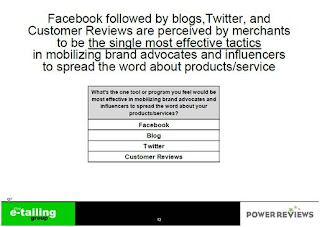
Which of the social media efforts are most effective in mobilizing advocates and spreading the word about their brand? Facebook! Reviews are at the bottom of the list and Twitter is next to the bottom. People do say that reviews influence their purchases; is that not spreading the word? I hope these retailers were paying attention to this year’s Black Friday/Cyber Monday Twitter efforts. The good news is that Twitter can have an immediate impact on sales. The bad news is that it takes time and effort to build a base of Twitter followers that permits impactful marketing. Bear in mind that it takes time and effort to build a following of Facebook friends also!
The Ad Age article gives examples of issues. Let me briefly tell the story:
• Shane Faerber is an individual developer who wrote an app, Mall Maps, for the competitive iPhone applications space (over 80,000 of them the last time I looked).
• When the app was launched he wrote the first review—with complete transparency. He said he was the developer, provided a video and invited feedback. He even put his email address in the app itself.
• He reached out to professional reviewers and media outlets, getting some positive notice and a ranking of 26 (out of about 18,000) in his category.
• Apple paid attention and on Tuesday before Black Friday named the Mall Maps a must-have. By Wednesday it had moved up to number 1 in its category. It was originally priced at $2.99. Today it’s on sale for $1.99 but I don’t see a current downloads stat.
Great as the success of the app is, that’s not what I found most impressive. Here’s the quote from Ad Age:
along the way, Mr. Faerber's hand turned a handful of dissatisfied customers into positive endorsers. One customer, whose initial review started with the opener: "SO FAR STINKS!" eventually wrote that he was "impressed with your customer service" and wished Mr. Faerber "the best of luck" after a series of e-mail exchanges with the developer.
What works?
• Reaching out to potential customers.
• Reaching out to the media, especially the online media for an online product.
• LISTENING to your customers. Even more, ENCOURAGING THEIR FEEDBACK!
Posted by MaryLou Roberts at 12:12 PM 0 comments
Labels: brand evangelists, brand loyalty, consumer engagement, consumer reviews, Facebook, social media strategy, Twitter
Friday, December 11, 2009
The Importance of Integration
I've been aware for quite some time that IBM was exploring the use of social media in various contexts. Today I listened to a webcast by Sandy Carter, Social Media Evangelist at IBM. The webcast has strategy, case histories, and advice on how to make social media initiatives work in an organization.
View the webcast here.
All those are very important subjects to the social media marketer. And the title makes the key point; marketers have to integrate social media into their overall marketing mix! Sandy Carter makes a strong argument for better results for existing marketing programs with the inclusion of social media component.
It's well worth the 40 minute duration of the webcast, now archived on BrightTalk.
Posted by MaryLou Roberts at 1:16 PM 0 comments
Labels: integrated marketing communications, marketer response to social media, marketing organization for new media, social media strategy
Wednesday, December 9, 2009
Communicating the U Wisconsin Snowball Fight
I don't usually do current event announcements, but this one is too good to pass up. Actually, I don't usually have The Weather Channel on for a long period of time but we're having an awful storm on Cape Cod--the kind where my yard furniture blows around and I listen to TWC to find out how far it might go and when it's safe to set it upright again.
The point is, however, that TWC knew that UWisconson Madison is closed today--a feed or manual monitoring, I don't know. However the local papers and broadcast outlets have picked it up also. Probably the first to know were students who quickly found out that their classes were canceled today!
A Facebook event page was quickly set up to announce a campus snowball fight at 2 p.m. I don't know what time the page was created but as of this writing about 1 p.m. EST, there are
- 5,482 confirmed guests
- 3,437 "maybe attending"
- 221 wall posts.
I made 2 screen captures, the first one something like an hour ago (I've been outdoors chasing yard furniture!). In that period of time the notice at the top of the posted image, **ESPN seeking videos" appeared. Ponder that!
I was already going to point out that this will be on the nightly news, and I wouldn't be surprised if CNN has it on live or at least has an Internet report before the event is over.

Note: While I was editing this someone from Madison located it! Wow!
Such is the power of instant, social-network-based communications!
Posted by MaryLou Roberts at 12:57 PM 0 comments
Labels: Facebook, social media, social networks
Monday, December 7, 2009
Contemporary Views on Business: Partnering for the Future

Contemporary Views on Business: Partnering for the Future" (Combi2010) is an important forum for knowledge co-creation and intellectual exchange emphasising partnering and international knowledge transfer as sources of competitive edge. In Combi2010, you are reserved plenty of time for lively dialogue, responsive thought transference and ideation.
Combi2010 joins the great minds of academics, business executives and other professionals from both private and public sectors to share and co-create knowledge on business-related topics. Furthermore, Combi2010 actively seeks to promote synergies between business and academia. Our international conference programme contains tailor-made modules to satisfy even the most demanding needs of faculty members, executives, entrepreneurs, and post-graduates.
Combi2010 is hosted by four Universities of Applied Sciences from the larger Metropolitan region (HAMK, Helsinki Metropolia, Laurea, LUAS) and being organised in collaboration with partners incl. e.g. ECR Finland, the Regional Organisation of Enterprises in Uusimaa and international scientific journals.
Calls for participation are open from 4 January 2010 onwards. Submit online at www.combi2010.fi your
· competitive paper manuscript not exceeding 20 double-spaced pages and/or
· poster presentation abstract of 1500-5000 characters and/or
· work-in-progress presentation abstract of 1500-5000 characters and/or
· special session proposals of not exceeding 5 double-spaced pages
See the Calls for the various types of submissions on this page.
Combi2010 has 19 Tracks representing the subject fields of Business Studies, Leadership and Entrepreneurship. Please consult the conference website for details. See the draft program, including keynote speakers here.
Best Paper in Conference will be awarded. All the accepted papers will be published in the printed, ISSN/ISBN identified, Conference Proceedings and in an electronic format on a USB drive. In addition to this, the best papers chosen by Track Chairs are eligible for publication as double blind peer reviewed articles at least in the International Journal of Technology Diffusion and International Journal of Management Innovation Systems. The Journal of Internet Banking and Commerce will publish a special issue on Combi2010 Conference Papers.
Keep your eye on the website for the latest developments.
The Calls close by the end of March 2010.
The Combi2010 Organising Committee awaits to see you in Finland next October!
Posted by MaryLou Roberts at 11:58 AM 0 comments
Labels: call for paper submissions, Combi2010, conference in Finland, conference in Vantaa, innovation
Friday, December 4, 2009
Does Behavioral Tracking Threaten Consumer Privacy?
According to a recent study by researchers at the Universities of Pennsylvania and California at Berkeley and sponsored by the Rose Foundation for Communities and the Environment, consumers think it does! Whatever marketers themselves think, these opinions threaten behavioral advertising, and we should take them seriously.
The New York Times had an excellent article when the report was published. It’s an important report, and I’d encourage you to use the link in the Times article and download it to read the entire thing. You will find careful methodology and a carefully chosen, if not huge, sample.
The findings are what’s most important, and here are two of the key ones:
• Even when they are told that the act of following them on websites will take place anonymously, Americans’ aversion to it remains: 68% “definitely” would not allow it, and 19% “probably” would not allow it.
• Americans mistakenly believe that current government laws restrict companies from selling wide-ranging data about them. When asked true-false questions about companies’ rights to share and sell information about their activities online and off, respondents on average answer only 1.5 of online laws and 1.7 of the 4 offline laws [questions] correctly because they falsely assume government regulations prohibit the sale of data. (pp. 3 & 4)
I think the incorrect beliefs about government regulations contribute to the aversion problem; it’s another instance of people feeling duped when they find out the truth. This is a societal problem, not a problem for any one business. Still, individual businesses can be open and honest about their own activities, building trust as they do so.
Both these issues are important but let me present just one chart on aversion to behavioral tracking with the two columns you need to compare highlighted.![]() First, note that the respondents are more willing to allow tracking when it produces discount offers they want. We’ve been seeing a lot lately about how intensively consumers are using the web to look for promotions and discounts, so that makes sense.
First, note that the respondents are more willing to allow tracking when it produces discount offers they want. We’ve been seeing a lot lately about how intensively consumers are using the web to look for promotions and discounts, so that makes sense.
Second, lower table, when the question includes specifics about the information used to tailor the ads, discounts and news, the percentage of people willing to accept goes down—a little less for discounts, but they all go down. Look further; when information is brought in from other websites (the essence of behavioral advertising) or from offline, the willingness to accept plummets.
The full report also had a breakdown by age segment. Younger people are more willing to accept the tailored offers than older ones, but there’s not as much difference as I expected. And younger people show the same pattern of being less willing to accept tailored offers when the source of information is specified.
This is disturbing to the Internet marketer, and there is no easy solution. There have been a few meager efforts by coalitions of businesses and trade groups to better inform users about the nature and benefits of collecting and using consumer data and the differences between anonymous and identified data. The efforts appear to have been half-hearted and it’s clear that they had little impact.
Worse, that’s the only real solution I can think of. Do you have any better ideas???
In the meantime, keep building your trusted brand!
Posted by MaryLou Roberts at 1:33 PM 0 comments
Labels: behavioral advertising, consumer data, consumer privacy, personalization, trust
Wednesday, December 2, 2009
Did You Get a Twitter Wake-Up Call?
Black Friday has been a retail shopping phenomenon, probably ever since shopping malls were invented. A few years ago, Cyber Monday joined the retail scene as an important online shopping day, although last year December 9 was actually the heaviest online shopping day of the year. This year, the lines seem to have blurred as the amount of online shopping continues to increase, stimulated by social media. Marketers are using social media to get shoppers revved up earlier, both in the stores and especially online.
I’ve written before about the importance of Twitter and Facebook to consumers who are looking for bargains. This year marketers took advantage of that to promote deals—sometimes on an hourly basis—on both days. The New York Times called it the "first Twitter Christmas” and has links to more examples of corporate marketing efforts. The Motley Fool has more.
Two examples:
• Penney is the one with the wake-up call—take your pick of a message from Cindy Crawford, Kimora Lee Simmons or Rascal Flatts. A wake-up call was needed; they started Tweeting special deals and coupons at 4 a.m. Black Friday morning. That’s good, but why do they have a Facebook link on their site but not a Twitter link? Worse, their Black Friday press release gave a twitter account link that doesn’t work. This annoying one does. http://twitter.com/JcPenney
• Best Buy has been pushing their TwelpForce since last summer, complete with television ads. I took a quick look around the blogosphere and there are some positive, some negative posts about its effectiveness, but Best Buy is clearly putting effort into it. It’s easy to find other customer service options from the Best Buy home page, but not TwelpForce.
Do you see a pattern here? The Twitter initiatives, especially for Christmas shopping, are important. Why are they so hard to find???
With apologies to an article I read over the Thanksgiving weekend and promptly lost, there’s a point beyond successfully integrating these social media efforts into the overall communications program. I’m not sure how Penney’s got the word out except for the zillions of Black Friday/Cyber Monday, coupons, and deals sites and blogs. Did they do some ads that included the Twitter deals? Perhaps; I didn’t see any. Best Buy used a significant amount of television to support the TwelpForce launch. These two firms are a small sample, but the skew is heavy in favor of Twitter and Facebook—non-paid media.
The article I read pointed out that newspapers stood to lose even more revenue as businesses come to understand effective uses of social media. Good for business, bad for newspapers. Today’s eMarketer newsletter quotes a study from The Center for Marketing Research at UMass Dartmouth that pointed out that “the Inc. 500, a list of the fastest-growing private companies in the US, is outpacing the larger, more traditional companies in the Fortune 500 in many social media activities.” (“Social Media Marketers Declare Success” December 2, 2009)
Could that be the biggest impact of social media on retailing in the long term? As small businesses wake up to social media like Twitter they will be able to reach their customers-- directly and in a timely fashion--with relevant information. The impact could be huge. Again, bad for newspapers and perhaps other local media, but very, very good for small businesses – and for all organizations that want direct, authentic communication with their target audiences.
That said, remember that I wasn’t signed up for Twitter from either Best Buy or Penney. One reason is that they never asked. Retailers have to aggressively build their networks—opt-in email lists, Facebook Friends, Twitter Followers and maybe others. Then they can, indeed, reach customers with timely, relevant information—information customers have chosen to receive!
Posted by MaryLou Roberts at 1:40 PM 0 comments
Labels: Facebook, integrated marketing communications, newspapers, social media metrics, Twitter
Tuesday, December 1, 2009
Augmented Reality meets Social Media meets the Christmas Holidays!
Augmented Reality has been getting a fair amount of attention lately. As Business Week puts it, brands are looking for new ways to engage their customers. Dorian Benkoil, writing in Poynter Online, has more intriguing examples and visions of the future. Can you believe the USPS now has an augmented reality app that lets you identify the correct box size for your item? Even more to the point, can you believe they have an excellent video that shows how it works? Since I don’t consider the USPS a hotbed of innovation, I found it difficult! Watch the video and see for yourself.
Stella Artois, the Belgian beer brand, announced an ecard yesterday that seems to combine the best features of AR and social media. Of course it’s a Christmas card! And it hits all the right notes, especially for the social media enthusiast!
• It’s fun and engaging.
• It’s carefully thought out. To get full benefit the recipient needs a webcam or smart phone to read the digital marker. If there’s not one available, it is viewable as a Flash ecard.
• It’s cause-related marketing. Each card sent will result in a tree saved in an ecologically-important area in South America.
• A live webcam in Hyde Park shows a tree with a light for each card sent. The goal is 1 million cards, 1 million trees saved, by Christmas.
Their video shows how the card works. If you view it with a webcam, you can move the picture around and you can move the snowflakes by blowing into your pc's mic.
What’s not to like about all of that? Congratulations to Stella Artois for the strategy and Bright Spark Digital for the execution! It’s not only cool technology, the spirit fits the season!
Posted by MaryLou Roberts at 10:55 AM 0 comments
Labels: augmented reality, brand engagement, customer engagement, marketing apps, social media
Wednesday, November 11, 2009
Online Shopping Gets Social
 Today’s eMarketer newsletter reminded me that I had intended to follow up some recent articles on social shopping. As so often happens, I found more than I expected. Start with the chart from eMarketer which compares the information sharing behavior of Gen X women (born 1960 to late 1970s) to those of Gen Y females (born late 1970s to late 1980s; see a discussion of cohorts on Wikipedia, also search the various generations). Whatever the exact “gen” definition you use, the older segment is more likely to share by telephone or email; the younger ones are more likely to share online. Not a huge surprise, so I went onto look at some of the material that had recently floated through my inbox.
Today’s eMarketer newsletter reminded me that I had intended to follow up some recent articles on social shopping. As so often happens, I found more than I expected. Start with the chart from eMarketer which compares the information sharing behavior of Gen X women (born 1960 to late 1970s) to those of Gen Y females (born late 1970s to late 1980s; see a discussion of cohorts on Wikipedia, also search the various generations). Whatever the exact “gen” definition you use, the older segment is more likely to share by telephone or email; the younger ones are more likely to share online. Not a huge surprise, so I went onto look at some of the material that had recently floated through my inbox.
Most of what I found we already know; retailers have  established a presence on the “big 4,” Facebook, YouTube, MySpace, and Twitter. A recent post suggested that the effort is worthwhile, but it’s admittedly hard to measure results. What I was interested in, though, was what retailers should do to encourage social shopping or sharing, however you want to characterize it. I focused on an article by Heidi Cohen in ClickZ. She lists 7 ways to exploit the social phenomenon. I’ll list just 2 that I found especially compelling:
established a presence on the “big 4,” Facebook, YouTube, MySpace, and Twitter. A recent post suggested that the effort is worthwhile, but it’s admittedly hard to measure results. What I was interested in, though, was what retailers should do to encourage social shopping or sharing, however you want to characterize it. I focused on an article by Heidi Cohen in ClickZ. She lists 7 ways to exploit the social phenomenon. I’ll list just 2 that I found especially compelling:
1. Make your message consistent across platforms. . .ensure that it's integrated with the rest of your marketing, both online and off. Consistency is key to having a believable and trusted brand!
2. Make attractive offers to social shoppers. They like them and pass them on!
I kept reading and found a comment by Keith Wiley of DecisionStep, a company I had not heard of. So I checked out his tool for social shopping, called ShopTogether. It looks like fun; more important, it looks like something women would do. I, for example, can visualize shopping with my daughter for presents for my grandsons using this tool. Check out their video. You can try the tool on Mattel’s ecommerce site.
Also think about how I found this social shopping tool. Someone from DecisionStep made a comment on the ClickZ article that led me to the site. The site had good content, and a blog post happened.
Food for thought for retailers; the rest of us can just go shopping!
Posted by MaryLou Roberts at 12:49 PM 0 comments
Labels: demographics, Facebook, social media behaviors, social shopping, Twitter, YouTube
Monday, November 9, 2009
Brand Attitudes and Behavior ARE Affected by Social Media!
The headline in the IAB newsletter says that “product chatter is getting louder on social media.” The article in MediaPost quotes data from a study by Performics that includes:
• 30% of their respondents had learned about a product, service or brand on a social site.
• 25% go directly to the site after hearing about it on a social site.
• 44% of respondents have recommended and 39% have discussed a product on Twitter.
• 46% have talked about or recommended a product, service or brand on Facebook.
Ok, so consumers are talking. Does it make a difference? The 2009 Razorfish FEED report says it does. That’s a big majority who say they are influenced!

How? The Razorfish data confirms that brand activity on the web can influence all stages of the consideration process. Attending events is powerful. Participating in a brand-sponsored contest or contest is even more so. These data also give support to the argument that social media have differential impact at different stages in the consideration process. Contests and sweepstakes have more impact on awareness; brand events have more impact on actual purchase. Wonder why the purchase impact. . .is it that brand events provide more content/information? Perhaps, but for sure the implication is that different types of promotion, even on the same platforms, may have impact at different stages. That’s important!
A study from Cone, recently reported by eMarketer, emphasizes the positive impact on brand attitudes that comes from brand interaction.
Razorfish says that the bottom line is: “Digital brand experiences create customers” (p. 11). Can you look at these data and doubt the truth of that statement?
Posted by MaryLou Roberts at 10:43 AM 0 comments
Labels: brand engagement, brand marketing, customer engagement, social media objectives, social media strategy
Friday, November 6, 2009
Social Apps--Equal Opportunity for All!
I saw Josh Bernoff’s article in Ad Age last week announcing the winners of Forrester’s Groundswell Awards. Here’s a link to the same article on Josh’s blog. When I scrolled through the list of winners, I was struck by the number of companies I’d never heard of or small companies on the list. There were relatively few large corporations in the finalists—take a look for yourself; I think you’ll find it enlightening. You can access all the submissions with reviews here.
I’m interested in the small business aspect. Before I take a look at that, it’s worth being explicit about their Groundswell model (see chapter 4, Strategies for Tapping the Groundswell). They added some categories for the contest, but the model provided the framework. In the B2C sector:
In the B2C sector:
Talking – Lion Brand Yarn

According to Forrester:
Lion Brand Yarn initially set out to build relationships with the online knitting community by talking with their customers via a corporate blog and podcast. As a result of an investment in people rather than products, they found themselves with a passionate and brand loyal group of knitters, who not only engage with the brand but impact the bottom line by buying and using products as a result of social media engagement.
Embracing – Scholastic Book Club

Scholastic (remember them from primary school?) set out to improve their already-successful classroom flyer promotion. According to Forrester:
Together with a private online community of 200 teachers and 100 moms, created with their partner Communispace, Scholastic went through each step of the product development process in 10 weeks. They developed not only a new flyer, but a new opportunity for Scholastic Book Clubs to connect with parents, kids, and teachers . . . The initial test phase of the new flyer resulted in a 3% lift in sales, which, if borne out in the national rollout, will mean millions in new revenue for Scholastic Book Clubs.
In the B2B sector:
Listening – CDW

Ok, CDW isn’t a small business. However, I submit that small retailers or distributors can follow their lead. This is Forrester’s capture of a page in the Large Companies community. Looking at their website, I’m willing to bet that CDW has communities for at least the five basic segments they list on their website, ranging from small business to health care, maybe more.
According to Forrester:
CDW continuously taps members of its private online communities for all kinds of indispensible advice on its products and services, marketing ideas, and innovation. The communities also have inspired new approaches to sales both in terms of generating leads and relationship building with prospects early in the sales process.
Spreading – MetricStream

MetricStream is a privately-held startup that provides regulatory compliance solutions. According to Forrester:
ComplianceOnline was built to serve as the premier destination for content, training, and advisory services dedicated to regulatory compliance, IT governance, and corporate risk management. Today, it attracts more than two million visitors annually, 500,000 registered member-base, and is now a strong lead engine for its parent company - MetricStream.
This is a non-random sample and it doesn’t do justice to all the information about the awards. My only regret is how few non-profits are represented. An award was given to a gutsy Australian town, Flowerdale, which was destroyed by wildfire and raised money online to rebuild.
Spend some time either on the winners page or the submissions page. I guarantee you’ll learn a lot and get some ideas. Small businesses can reach out to their customers and engage them in mutually beneficial activities. Larger businesses can show that they value the individual customer’s ideas and opinions. It's a win-win for both!
Posted by MaryLou Roberts at 1:02 PM 0 comments
Wednesday, November 4, 2009
These Really are 10 Things Social Media Can't Do
I don’t often read an article and say, “ I simply cannot say it better.” In the case of this article in Ad Age Digital, which is getting a lot of attention on Twitter this morning, I really can’t say it better.
B.L. Ochman had me at number one:
Social media can't:
1. Substitute for marketing strategy.
The 9 that follow are equally good; read it quickly before it goes subscription only!
I couldn’t resist a bit of follow-up also, so I looked for some lists of failures. I found 2 good ones from May of this year. Jennifer Leggio, writing for ZDNet, had no trouble listing “the nine worst of the year—so far.” Read and heed. Denise Zimmerman had some good commentary on 4 social media campaigns in iMedia Connection about the same time.
Both mentioned Skittles, which I wrote about last spring when they made their entire home page into a Twitter page. I checked again, and here’s what I found. This is skittles.com. A landing page? I guess so. The real issue is to keep young people off. Under 13, under 18; I couldn't tell; they cooked my site when I gave (dishonestly) my age. Why? Not anything that Skittles is saying, but some of their contributors are quite foul-mouthed.
This is skittles.com. A landing page? I guess so. The real issue is to keep young people off. Under 13, under 18; I couldn't tell; they cooked my site when I gave (dishonestly) my age. Why? Not anything that Skittles is saying, but some of their contributors are quite foul-mouthed. This is what you get when you click "Home." Honestly! You get their Flickr page!!!
This is what you get when you click "Home." Honestly! You get their Flickr page!!! Their Twitter stuff is still there, it's under Chatter now. I went to the effort of a screen capture that didn't have any obscenities. It took quite a bit of scrolling.
Their Twitter stuff is still there, it's under Chatter now. I went to the effort of a screen capture that didn't have any obscenities. It took quite a bit of scrolling.
Sorry, but I just can’t see any of this qualifying as a strategy! And why should a candy product want to support content that makes its site unacceptable for underage web users? It boggles the mind!
Let me end with a quote from Denise Zimmerman’s article:
Have a clear goal in mind for social media programs, and focus efforts on achieving it. Know your audience. Create something of mutual value. Observe and listen to what your customers are already doing and saying. Recognize that certain aspects of social media require an ongoing commitment. If you discover that you miscalculated your resources or a path you chose was not ideal or suited to your objectives, then regroup to move positively forward. Create your own definition of success against the available opportunities and align your programs, resources, and expectations accordingly.
Have a strategy, evaluate your progress toward its goals, and realign if necessary. Amen!
Posted by MaryLou Roberts at 10:18 AM 2 comments
Labels: social media, social media strategy, Twitter
Tuesday, November 3, 2009
Target Readies for Holiday Shopping
As I was writing yesterday’s post on search and social media, I was trying to recall some recent news. I thought I remembered that Target had already announced free shipping for Christmas, so of course, I searched. What I found suggests a savvy marketer who understands the changes in consumer online shopping and search behavior.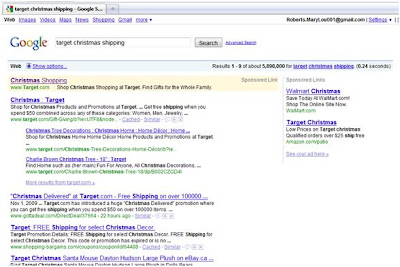 I searched “Target Christmas shipping.” I didn’t have to look for a news article; I found a paid search ad from Target as well as top organic placement for their Christmas page—ugh; Halloween was day before yesterday! But it was there, complete with a WalMart paid ad in second place. Both the pay per click ad and the organic result linked to the Christmas page on the Target site. And I was right; they have a shipping deal. Note that other sites/bloggers are already plugging the free shipping for them! I didn’t follow those to see whether it was normal buzz or whether Target was reaching out. Wonder if they have to reach out, or if they just get the buzz because they are Target . . .
I searched “Target Christmas shipping.” I didn’t have to look for a news article; I found a paid search ad from Target as well as top organic placement for their Christmas page—ugh; Halloween was day before yesterday! But it was there, complete with a WalMart paid ad in second place. Both the pay per click ad and the organic result linked to the Christmas page on the Target site. And I was right; they have a shipping deal. Note that other sites/bloggers are already plugging the free shipping for them! I didn’t follow those to see whether it was normal buzz or whether Target was reaching out. Wonder if they have to reach out, or if they just get the buzz because they are Target . . .
It’s a well done page, but nothing particularly special. There’s email, personal pages, gift cards, and all the other holiday and gift services you’d expect from a world-class retailer. Interestingly, I didn’t see anything social on the website, so I checked out their Facebook page. Target has 567,758 fans, including some of my friends; I didn’t realize you saw people you knew when you visited a corporate Facebook page. Makes sense! No Christmas promotions, though—not yet anyway! I also looked on Twitter, but didn’t find Target there. Trying to be sure, I looked on the Target home page. No link to their Facebook page (seems like an oversight to me) and no link to a Twitter page. I’m ambivalent about whether they’ve integrated this promotion into social media as they should. They’ve done the search, both paid and organic, well. Is it too early for holiday postings on Facebook? I think so. It will be interesting to look later in the season and see if holiday promotions begin to appear on their Facebook page and on other shopping sites; also to look at whether it’s Target doing the promotion or whether it’s their adoring shoppers writing about a retailer they love.
I’m ambivalent about whether they’ve integrated this promotion into social media as they should. They’ve done the search, both paid and organic, well. Is it too early for holiday postings on Facebook? I think so. It will be interesting to look later in the season and see if holiday promotions begin to appear on their Facebook page and on other shopping sites; also to look at whether it’s Target doing the promotion or whether it’s their adoring shoppers writing about a retailer they love.
Also, while one role of social media is to bring consumers to the website, if Facebook, Twitter and other social networks are part of the marketing communications mix, it makes sense to put them on the home page. I’d be willing to be that there’s little activity from home pages to social nets; just call it another awareness thing.
The take aways? As the studies quoted yesterday say, search is still the main driver, but the social networks are full of brand buzz. Also, integration is key, but integration that understands the role of different media at different points in the sales funnel.
Posted by MaryLou Roberts at 9:00 AM 3 comments
Labels: Facebook, social media objectives, social media strategy, social shopping, Twitter
Monday, November 2, 2009
Marketers Should Put Social Media in their Christmas Stockings
As a consumer I refuse to think seriously about the Christmas holidays yet. Retailers, however, see it looming before them and should be getting ready.
In that spirit, I downloaded a study from OneUpWeb on the 2009 holiday shopping season. They expect the increase in online holiday shopping to continue this year. The sentence that caught my eye was not a surprise either, but provided food for thought: “consumers are more engaged with online ratings, reviews and initiating conversations about products and services” (p 3). The news here is that shopping habits, and consequently the way shoppers arrive at websites, is changing.
Here’s the summary of their findings:
• In 2008, holiday traffic directly to retail sites was down ten percent from 2007.
• On average, traffic to social sites outpaced retail sites, growing 12 percent from December 2007 – December 2008.
• Traffic to the review sites remained stagnant throughout the year, experiencing a mild bump during the holiday season. (p. 7)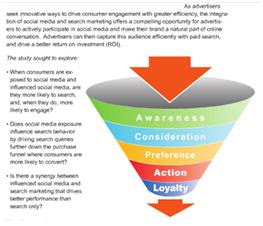
The OneUpWeb study took its cue from one on the role of social media in the consumer purchase process by GroupM Search. I checked that one out also and found a useful perspective. The text in the graphic suggests they believe, as many of us are coming to accept, that social media are more useful in the early, awareness and consideration, stages of the funnel. That’s good; we can reach more people with what’s essentially not-precisely-targeted branding message. Then, in the later stages, we can use paid search media to reach a better defined target that is moving closer to a purchase. In their words:
As expected, social media exposes consumers to brands, their products, the benefits of their features, and corporate value propositions. It clearly presents a powerful and often underutilized way for brands to become part of the consideration set. This is an important learning because it helps situate social media in the marketing landscape—not as a conversion or direct response channel, but rather as an exposure and awareness vehicle. (p. 5) The data is a bit complex and I’d encourage you to read the report for yourself. This chart looks at the likelihood of searching when social media is added to paid search advertising alone (the green bar). Consumers who were also exposed to social media relevant to the product category searched exhibited a substantial increase in search behavior (the dark green bar). Consumers who were also exposed to social media influenced by the marketer exhibited an even greater increase in search behavior (the blue bar).
The data is a bit complex and I’d encourage you to read the report for yourself. This chart looks at the likelihood of searching when social media is added to paid search advertising alone (the green bar). Consumers who were also exposed to social media relevant to the product category searched exhibited a substantial increase in search behavior (the dark green bar). Consumers who were also exposed to social media influenced by the marketer exhibited an even greater increase in search behavior (the blue bar).
Is it surprising that social media should be integrated with search marketing? No, not at all. Is it helpful to say that social is most useful when consumers are exposed in the awareness and consideration stages? Yes, it is. Does the data provide support for social media activity by marketers? Yes, it does. Is it good news that we can get more bang for our paid search buck by including social media in the mix? Absolutely!
Are any marketers moving in this direction? It seems so. Stay tuned for a short case study which closes the circle to the holiday shopping season!
Posted by MaryLou Roberts at 12:31 PM 0 comments
Labels: integrated marketing communications, search, social media, social media strategy
Friday, October 30, 2009
Kraft Celebrates Football Season with Social Media
When I wrote about the Kraft iFoodAssistant widget recently, I realized that Kraft had more going on in social media and resolved to look into it. When you look, you find all the usual blogs pointing out coupon availability, which is ongoing for most CPG brands. It certainly is a new way of distribution though; and therein lies one social media impact.
What you also quickly see is two seasonal promotions for Velveeta cheese. Tis the season for tailgating or football on TV, and snacks made with Velveeta cheese are a seasonal item. The Kitchenistas blogger promotion has been going on since September; here's the microsite. In fact, today is the last day of activity for the five compensated “Mommy bloggers” who have participated in the promotion. How does this kind of promotion affect sales? Velveeta brand manager Sherina Smith admits they don’t really know:
How does this kind of promotion affect sales? Velveeta brand manager Sherina Smith admits they don’t really know:
“It’s hard to say,” Smith says. “What we do know is that this consumer is online looking for ideas for meals. We know she blogs a lot and looks to other bloggers for tips and ideas. The more that we can be where she’s looking for ideas, the more we can be top of mind when she’s grocery shopping.”
All this context seems to create warm fuzzies for the brand, and that may be all we can say at present. I’d love to know the ROI of a low-cost promotion like this, incorporating real people, compared with the ROI of, say a traditional television commercial. Yes, I’d like to know, but what is the dependent variable—brand awareness, favorable brand attitudes, what? We’re back to the difficulties of measuring attitudes and their impact on behavior. Marketers have operated on faith that positive brand associations do matter for a long time, and I don’t think that’s going to change any time soon.
Enter the Big 10 promotion, also for Velveeta and also tied in with football season. Here’s the Big 10 Conference home page for today. Note a banner ad at the top by Rotel with a dish of cheese dip beside it. You probably won’t be surprised when you click through and find that most of the featured recipes feature Velveeta cheese. Rotel is a ConAgra brand with a non-corporate-looking website that pushes recipes and attitude.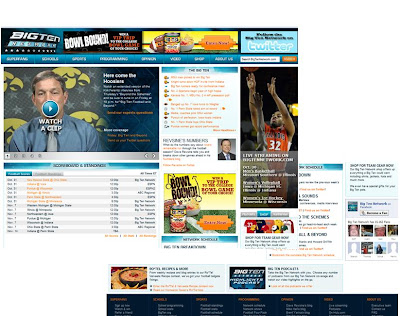 Note that on the Big 10 home page there’s a square box pushing a contest for bowl tickets, again featuring Rotel. At the bottom of the page there is another banner that makes the Rotel Velveeta partnership more explicit. It’s all quite integrated—and hard to miss!
Note that on the Big 10 home page there’s a square box pushing a contest for bowl tickets, again featuring Rotel. At the bottom of the page there is another banner that makes the Rotel Velveeta partnership more explicit. It’s all quite integrated—and hard to miss!
Kraft’s website, the iFood Assistant, and one guesses its relationships with bloggers will go on. Promotions for various brands, many of them seasonal, can also be expected to continue. What do you suppose they have on tap for Thanksgiving and Christmas? Stay tuned!
Posted by MaryLou Roberts at 12:47 PM 2 comments
Labels: best practices, brand marketing, branding, consumer engagement, promotions, social media, social media metrics, social media strategy
Thursday, October 29, 2009
Inventing A Successful "New" Business Model
Do you have any idea how hard it is to keep a business going year-round in a resort area? I remember reading several years ago that the summer population of the town where I live is 20,000; it goes down to 5,000 for the winter months. If you consider that the peak season is no more than 10 weeks long, with “shoulders” on either side, you begin to understand the problem. Add to that the difficulty of finding housing for seasonal workers, and you have a prescription for small business woes.
Having emphasized with the businesses where I trade for a long time, I was intrigued with one I ran across recently. Two young women have invented a business model that allows them to solve the seasonality problem. The video is about two years old, so the statistics are out of date, but the energy and charm of these two entrepreneurs is much in evidence. Megan Murphy and Catherine Bean have a single retail location in downtown Hyannis. That’s a
Megan Murphy and Catherine Bean have a single retail location in downtown Hyannis. That’s a high-visibility tourist destination and their store obviously does well in the spring, summer and fall months. Their website supports the retail store, but it does more. They close the shop from December to March, but they don’t cease operations; they just shift to the Internet. They stay fully occupied running online parties and fundraisers. When I
high-visibility tourist destination and their store obviously does well in the spring, summer and fall months. Their website supports the retail store, but it does more. They close the shop from December to March, but they don’t cease operations; they just shift to the Internet. They stay fully occupied running online parties and fundraisers. When I
talked to Megan a few weeks ago, they were booked through Christmas. I checked the site and they are now booking for February and March 2010, so they continue to move right along.
 How did they invent this business model—one which is different from the usual Bricks & Mortar? As stay at home Moms, they gave product parties in their homes, so moving parties online didn’t seem like too much of a stretch. They found a supportive marketing services supplier, and they were off. From a few email addresses collected in the store, they now have a list of over 20,000 that grows with every party.
How did they invent this business model—one which is different from the usual Bricks & Mortar? As stay at home Moms, they gave product parties in their homes, so moving parties online didn’t seem like too much of a stretch. They found a supportive marketing services supplier, and they were off. From a few email addresses collected in the store, they now have a list of over 20,000 that grows with every party.
What is the moral of this story? Give eparties? While I think virtual events have a great future, it’s more than that.
These two women used their own experience, their own background; they just moved their offline activities online. Think about your last online retail experience. Did the site “suggest” other items to you the minute you put something in your shopping cart? That’s what a good retail salesperson does, just moved online. That’s the moral—move successful offline marketing activities online.
There was a blog post last week by Mack Collier that got a lot of mileage on Twitter. I don’t disagree that we need fewer social media stars and more great social media ideas. My reaction was, “How do you know it’s really a great idea?” And then I thought about Megan and Catherine. Product parties had already worked for them in one context. They moved the same winning idea into another context, one where they could achieve even greater reach.
It’s a great example of not having to reinvent the wheel to develop a winning business model!
Posted by MaryLou Roberts at 11:30 AM 0 comments
Labels: business models, email marketing, fund raising, online events
Wednesday, October 28, 2009
Engagement Lessons from Successful Brands
An interesting customer engagement study has been sitting on my desktop since late summer and it’s long since time to pay attention. The study, by Wetpaint and the Altimeter Group ranks the top 100 brands in terms of customer engagement. You can see the ranking and download the full report here.
Starbucks and Dell are number 1 and 2—no surprise there. They interviewed some other high-ranking sites, SAP at 9 Toyota at 21—about best practices, presumably to get a perspective from different industry sectors. Each of the highly engaging brands has several best practices to suggest and they are worth reading the full report. I picked out one from each that struck me as universally applicable:
Starbucks identifies people throughout the organization to be the liaison with the social media program—to monitor and to take action on customer issues and ideas. At the same time, they maintain tight central control over content and the engagement of individual baristas in their many outlets.
Toyota says you have to be in it for the long haul. No surprise there; social media is an investment of time and energy that will only pay off over time. That’s a disappointment to many who are looking for immediate returns.
SAP makes a practice of engaging in new channels where people already are. That makes it easier to listen and understand; they also encourage employees who are already active on newer channels like Twitter.
Dell points out that you have to be conversational from the start. Again—not a surprise, just really hard to do, especially for newbie brand practitioner.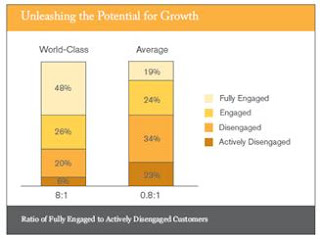

The Wetpaint/Altimeter group links customer engagement to financial performance and argues that it is a more powerful driver that traditional measures of customer satisfaction. Gallup consulting agrees, and has their own measures of engagement that allow them to group firms by level of engagement. You can read their full report here.
While researching this post, I also ran across a recent article in Forbes that argues for the importance of engaging customers while admitting that engagement is hard to measure. None of this content could be judged as totally unbiased because all the marketing services/consulting firms represented have a stake in creating or measuring engagement.
For me, it’s hard to refute the arguments. You should make your own judgment!
Posted by MaryLou Roberts at 11:05 AM 0 comments
Labels: best practices, brand marketing, customer engagement, engagement
Monday, October 26, 2009
The New CNN - Marriage of Site and Social?
Very early this morning I heard John Roberts and Kiran Chetry introducing the new CNN website on American Morning. Even at the early hour it sounded interesting, so I checked it out.
CNN's web designers seem to have brought as many different types of content to the home page as possible. It has latest news and features -- both headlines and videos, most popular (newspulse), a whole banner of editor’s picks videos in a banner across the middle of the page and topic boxes with links to stories. I think that sounds confusing, but it’s well organized and easy to follow. Take a look for yourself. It was the personalization and social features that I was most interested in, though. There are more, but here are two that I investigated. I set up a profile, personalized my weather for Boston (easy), tried to upload a picture (didn’t work), and followed some topics, which John and Kiran said was easy. I didn’t find it so, at least initially, but as you can see, I did
It was the personalization and social features that I was most interested in, though. There are more, but here are two that I investigated. I set up a profile, personalized my weather for Boston (easy), tried to upload a picture (didn’t work), and followed some topics, which John and Kiran said was easy. I didn’t find it so, at least initially, but as you can see, I did  make it work. I wanted to follow Tech and thought I’d get latest headlines. All the RSS feeds to that macro level of topics are still there, but that wasn’t what I was looking for. What I found was that I had to read an article; at the end there was a Follow This Topic button. Hitting that button usually gave me several keyword-type choices which then showed up on my profile page. The topics are rather micro for my taste, but it will be interesting to follow them for awhile and see what shows up. You can follow up to 12 topics, which on the one hand is enough to keep up with, but on the other hand may not give the reader much of a perspective, given the small scope of most of the topics.
make it work. I wanted to follow Tech and thought I’d get latest headlines. All the RSS feeds to that macro level of topics are still there, but that wasn’t what I was looking for. What I found was that I had to read an article; at the end there was a Follow This Topic button. Hitting that button usually gave me several keyword-type choices which then showed up on my profile page. The topics are rather micro for my taste, but it will be interesting to follow them for awhile and see what shows up. You can follow up to 12 topics, which on the one hand is enough to keep up with, but on the other hand may not give the reader much of a perspective, given the small scope of most of the topics.
I’m not an iReporter, but I was interested in what’s happening on the citizen journalism front. What was new to me was the concept of “vetted” iReports. These reports have been checked (for correctness, acceptability, they don’t say exactly what) by CNN editors. One assumes that’s an attempt to give credibility to citizen journalism. On the iReport main page they have an Assignment Desk where readers can get story ideas while in search of their 15 minutes of fame. That’s interesting, but I don’t think it’s the real purpose, for CNN or for local news sites. News happens and often reporters aren’t on the scene, but people with their phone cameras are. With that in mind, CNN just launched an iPhone app so people can upload iReports directly from 3GS iPhones. Events and breaking news seem to be the whole point!
As I looked as this I was reminded of a section of last year’s Razorfish FEED report (now hard to find but is on SlideShare). The chapter on usability/Dr. Nielsen is what I was recalling and here is the provocative quote:
The New Building Blocks
Jakob says:
People don’t read your websites; use a different editorial style and make your pages “scannable.”
We say:
Throw away your concept of primarily designing “pages” as building blocks and start designing experiences. (slide 20)
I think that’s what CNN is trying to do. Call it engagement, call it offering experiences, it may be a guidepost on the road to the future of the web. It’s an experiment worth following.
Posted by MaryLou Roberts at 11:31 AM 0 comments
Labels: content, engagement, TV, user generated content
Friday, October 9, 2009
Carefully-Monitored Community for Students and Their Parents
I’ve spent most of my adult life on college campuses and an innovative approach to communicating with a college community always interests me. So I was interested in the Auburn Family site when a colleague sent me the link—thanks, Nancy!
First, let’s be clear about what the problem is. Colleges and universities don’t want parents and alumni to hear or see the raw, unfiltered accounts of what their students are doing; you know, the kinds of things that all-too-frequently show up on MySpace and Facebook. Students have the same problem; they don’t want their parents to know all of what they are doing at school. This problem led to the unceremonious closing of some of the early social networks that schools set up. This is well known in the higher education community, and schools have struggling with a way to give voice to their students—in a way that will not alienate their parents and the alumni of the school, the latter being donors, of course.
Auburn University has come up with a model that has promise. The concept comes from public relations professor Robert French and 30 of his design and management students designed and built it and currently do most of the posting. The site was launched on or about September 20 and at this moment it has 1,386 members. Take a look at the pictures; it appears to be a nice mix of students and parents. While you’re on the site you can hear the Auburn War Eagle fight song and, oh yes, there’s a link to the admissions office.
No secret is made of the fact that the site is under the total control of the students, their professor, and the University. Here is a quote from their site guidelines:
Because Auburn prides itself on its friendliness and thinks of itself as a family, and because this site will attract prospective students and visitors who want to know more about Auburn, photos, comments, and other postings must not be offensive or suggestive in any way. Since the space being utilized is part of the Auburn.edu domain, the university reserves the right to remove any postings and content at any time. (this phrase is underlined in the original)
All posts and comments are moderated on stories and videos posted here. Your posts will be moderated as soon as possible. The site is monitored throughout the day. (underline and bold theirs, not mine!)
They’ve got clear guidelines and people to do the community monitoring. According to the local newspaper, Prof. French:
wants to make sure the site is safe and clean for anyone to join, meaning anytime someone requests approval, there's a vetting process.
As you can see from the site guidelines, that applies to all content, not just to people who wish to sign up for the site. The goal is clearly to keep this a nice, clean site that no alumni donor can reasonably object to! Same goes for parents, especially parents of prospective students!!
Will this site be too controlled, too sanitized, for some Auburn students? Absolutely, it will. They have other places to post their commentary, pictures and videos. They may just be hoping that their parents don’t see those!
This is perhaps an extreme example of community monitoring and control, but I submit that it’s necessary for what Auburn wants to accomplish. What do you think?
Posted by MaryLou Roberts at 11:50 AM 2 comments
Labels: community, community monitoring, social media strategy, user generated content
